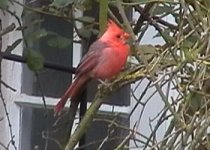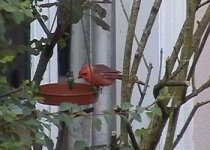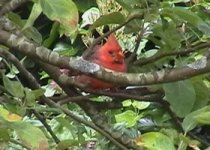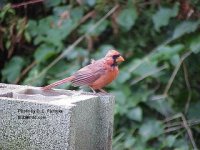Dear all,
For the past four or more days now a Northern Cardinal has been feeding on and off on seed in a backyard of a house within a mile of the sea in Paignton, Devon ( a county in the SW of England).
Given the enthusiasm UK birders have for rarities, to date, only 16 UK birders have bothered to see it (including myself). Why is this?
Firstly, being a species that is non-migratory, it would have to be ship assisted to reach our shore, which in itself isn't a problem, but secondly, the colour of the plumage is not typical for a male Northern Cardinal (see photos below). So the bird has been labelled a presumed escape and left at that.
Strangely enough, there have been several claims of Northern Cardinals in the UK in the past few years including at least one claim from Ireland. None have remained for more than a day though.
I've got no knowledge of Northern Cardinals or their plumage variations, hence this request for any comments on it that you would like to make. I actually wondered if the bird could be unwell and whether that could cause the plumage to be aberrant. The area at the base of the bill seems a little bare, or maybe this is the remains of a previous meal, but I'm not sure.
Are Cardinals exported for the cage bird trade? Does diet affect the plumage?
Once again, please let me know if you have ever seen a Cardinal looking like this one and if so, was there any obvious reason for it?
Thanks very much for your help,
Lancey ( UK birder)
For the past four or more days now a Northern Cardinal has been feeding on and off on seed in a backyard of a house within a mile of the sea in Paignton, Devon ( a county in the SW of England).
Given the enthusiasm UK birders have for rarities, to date, only 16 UK birders have bothered to see it (including myself). Why is this?
Firstly, being a species that is non-migratory, it would have to be ship assisted to reach our shore, which in itself isn't a problem, but secondly, the colour of the plumage is not typical for a male Northern Cardinal (see photos below). So the bird has been labelled a presumed escape and left at that.
Strangely enough, there have been several claims of Northern Cardinals in the UK in the past few years including at least one claim from Ireland. None have remained for more than a day though.
I've got no knowledge of Northern Cardinals or their plumage variations, hence this request for any comments on it that you would like to make. I actually wondered if the bird could be unwell and whether that could cause the plumage to be aberrant. The area at the base of the bill seems a little bare, or maybe this is the remains of a previous meal, but I'm not sure.
Are Cardinals exported for the cage bird trade? Does diet affect the plumage?
Once again, please let me know if you have ever seen a Cardinal looking like this one and if so, was there any obvious reason for it?
Thanks very much for your help,
Lancey ( UK birder)








